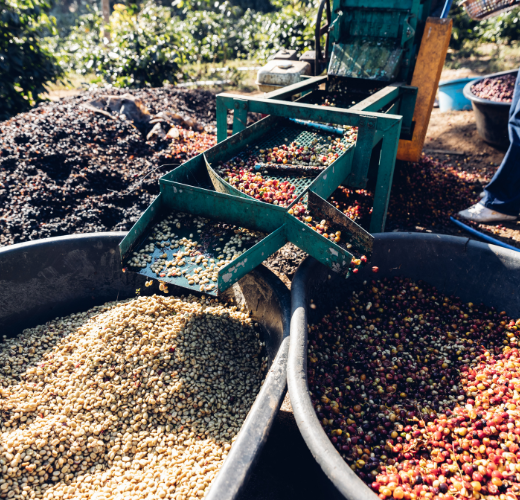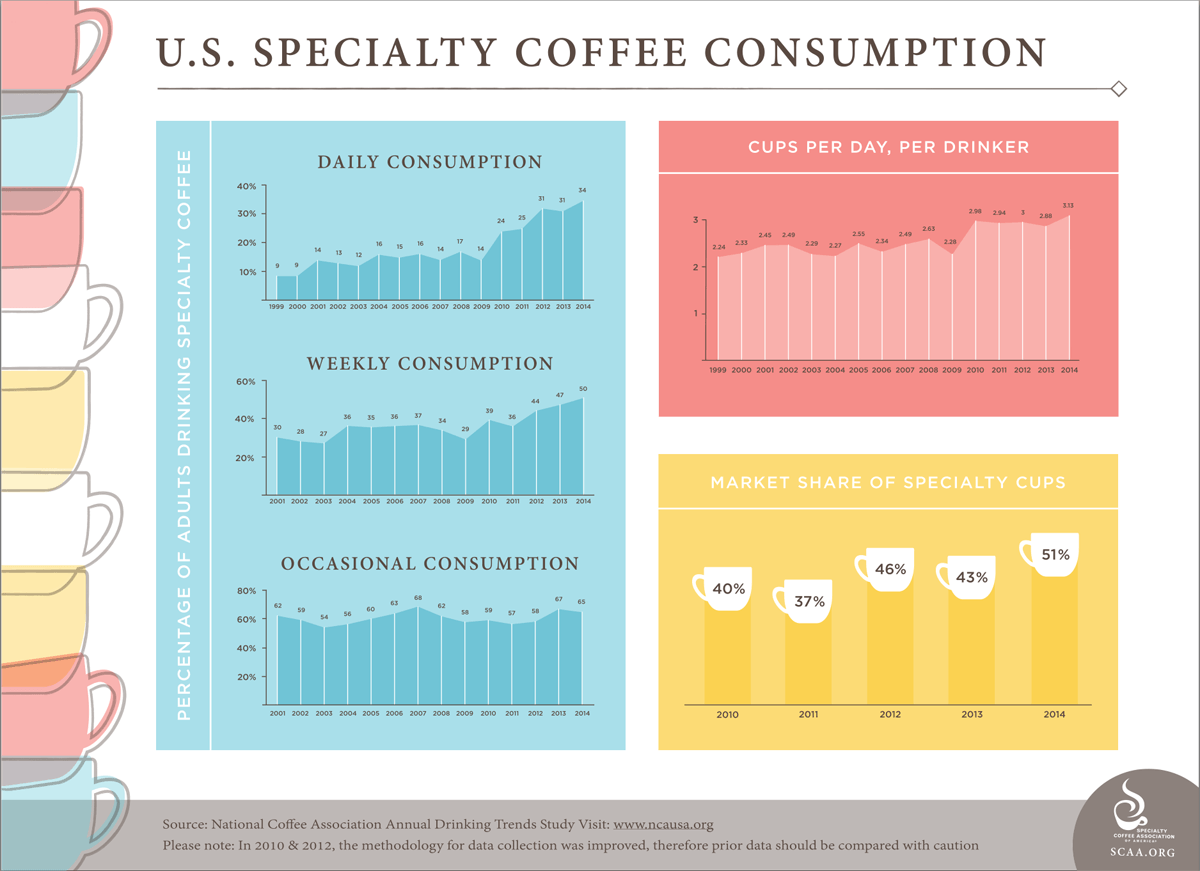Understanding How Coffee is Processed

Coffee processing is a diverse and evolving practice combining techniques hundreds of years old with modern scientific innovations. After harvest, coffee is prepared for transport, and eventually roasting, by removing the coffee seed (bean) from the coffee cherry and then slow drying it. These steps take a variety of forms which each “immutably alter” the coffee’s flavor profile in unique ways (Kornman, 2022).
Why Coffee Processing Matters
Chris Kornman cites a study in his book, "Green Coffee," that Nestle researchers found “processing type is the single most important factor determining a coffee’s final flavor profile” (Kornman, 2022). Understanding the different processes will help guide you when selecting a coffee to purchase and enjoy at home. You'll often see the process listed on the bag: Natural/Dry, Washed/Wet, Honey, and Wet-hulled are common, but you may also start to see Anaerobic, Carbonic, or other unique processes. All coffee processing methods share is a step called fermentation.
Fermentation
Setting aside a strictly scientific definition, it suffices to understand fermentation as the breakdown of organic material by microbes which produces alcohol, CO2, and a variety of acids (Kornman, 2022). Used to loosen the mucilage (fruit) from the coffee seed (bean), the conditions and duration of the fermentation also significantly impact flavor expression. The oldest and simplest process is the Natural/Dry process.
Natural/Dry Process
Also referred to as Traditional Dried, Sun-dried, or Cherry-dried, the natural process leaves the coffee seed (bean) in the cherry to ferment for roughly two weeks. This step can take place on large cement patios or on raised beds for better air circulation. The coffee is rotated multiple times per day to ensure even drying. Later, the seed (bean) is removed from the cherry using a pulper.
Flavor Profile
Natural coffees tend to have bold fruit flavors developed during the time spent in contact with the fruit’s flesh. Blueberry, strawberry, peaches, and a host of tropical fruit flavors can be found in natural/dry processed coffee. A criticism of the natural/dry process, however, is the potential loss of origin-flavor or terroir beneath a homogenized “process” flavor. Further, if the fermentation is not controlled properly, overly sour flavors can arise giving the coffee an “off” taste.
Washed/Wet Process
As the name implies, the Washed/Wet process involves soaking the coffee seeds in water for 12 to 48 hours. First, most of the mucilage, the flesh of the coffee cherry, is removed using a pulper which may be a simple hand-cranked machine at a small holder’s farm, or a much larger machine operated by a washing station or collective.
Fermentation and Washing
After pulping, a bit of the mucilage (fruit) sticks closely to the coffee seed (bean). In large open-air water tanks, the fermentation process breaks down the remaining mucilage. After fermentation, the coffee is moved through long shallow troughs which washes away the softened mucilage. During this process, lower quality coffee, which floats easily through the troughs, can be separated from the higher quality coffee which sinks to the bottom.
The Role of Wet Mills
Some washing stations, called “wet mills”, also begin the washing process by floating the coffee cherries to separate them from underripe cherries and debris or end it with a final washing step. These processes are noted as “double-washed”, or “triple-washed” if both steps are undertaken.
The Flavor Profile and Environmental Impact
Washed/Wet processes get a lot of praise for preserving the origin or terroir flavors of a coffee. Delicate, subtle, and complex flavor profiles that mingle, evolve, and interact on the palate make washed/wet processed coffees popular among coffee enthusiasts. Unsurprisingly, however, washed/wet processing involves large amounts of water making it comparatively wasteful and even completely unviable in some locations.
Honey Process
The Honey process, sometimes called Pulped Natural or Semi-washed, falls somewhere between the natural and washed processes. The coffee cherry is pulped like a washed coffee but then bypasses the washing step and is, instead, allowed to ferment on patios or raised beds like the natural process. A color system is used “to vaguely indicate the amount of fruit left on the seed while it dries, from most to least: black, red, yellow, white” (Kornman, 2022).
Flavor Profile
As you might expect, the honey process yields a flavor profile between the bold fruit flavors of a natural and the subtle nuances of a washed. The specific amount of mucilage remaining, drying times, and other factors determine which end of the spectrum a particular honey process leans.
Anaerobic and Carbonic Processes
As demand for increasingly unique coffees has grown, so has the variety and complexity of coffee processing. Anaerobic, literally “no-oxygen”, and carbonic, “carbon dioxide-rich”, processes involve holding the coffee, either whole cherry or pulped, in a low oxygen environment inside a sealed tank. The rest of the process can follow either natural or washed procedures. Increasingly, specialty coffee processors are borrowing techniques from the wine industry like “carbonic maceration” a process involving whole cherry fermentation in a carbon-rich environment. Another developing process entails inoculating a batch of coffee with a specific microbe to produce a predictable and consistent effect on the flavor profile. An example is the use of Koji, a cultivated mold used to make soy sauce, sake and other foodstuffs. These techniques are still in their infancy but promise new and interesting coffees in the future.
Wet Hulling
Wet Hulling, predominantly used in Sumatra, is a process similar to the washed process but the parchment, a layer between the mucilage and the seed, is removed before the final drying process.
Flavor Profile
Cherished by some, wet hulling sometimes produces a flavor profile which would be considered a defect in other methods, specifically woody or musty flavors.
Drying Coffee and the Dry Mill
After the processing methods described above, coffee must be dried to between 10 and 12% moisture content which renders it shelf stable and ready for roasting. This step is carried out on large patios, raised beds, or industrial dryers usually over a period of weeks. After drying, industrial equipment is used to remove the final remaining layer, the parchment, from the seed (bean) at a processing point known as a dry mill. As the equipment required for dry milling is large and expensive, dry mills tend to operate independently from the other steps in coffee processing.
Expanding Your Coffee Horizons with Driven Coffee
Coffee processing continues to evolve as demand for unique coffees grows and processing techniques are expanded and refined. Understanding each process and the associated flavors will help coffee drinkers like you find exciting new coffees and avoid coffees you might enjoy less. At Driven Coffee we provide coffees processed a variety of ways so there is sure to be something you’ll love. Thanks for taking the time to learn more about coffee processing and for supporting us in our quest to bring you the most delicious coffees we can find! Slim Pickens signing off.References Kornman, C. (2022). Green Coffee A Guide for Roasters and Buyers. Roast Magazine.





